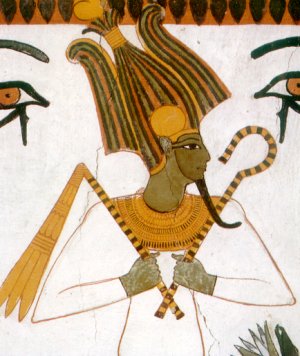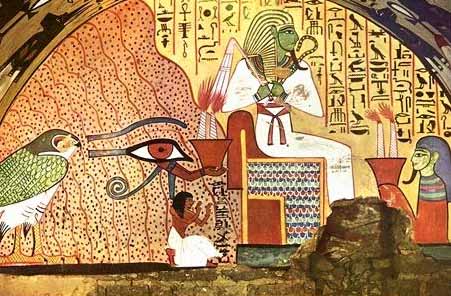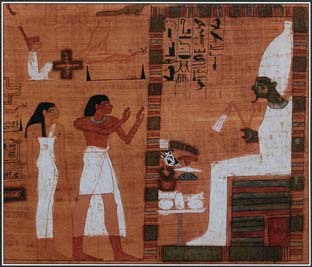
Osiris, Usire Asar, Ausar, Unnefer,
Wesir
From the hieroglyphic texts of all periods of the dynastic history of Egypt we learn that the god of the dead, par excellence, was the god, whom the Egyptians called by a name which was commonly known to us as "Osiris." The oldest and simplest form of the name is written by means of two hieroglyphics, the first of which represents a "throne" and the other an "eye," but the exact meaning attached to the combination of the two pictures by those who first used them to express the name of the god, and the signification of the name in the minds of those who invented it cannot be said. In the late dynastic period the first syllable of the name appears to have been pronounced Aus or US, and by punning it was made to have the meaning of the word usr, "strength of the Sun-god Ra.
This meaning may very well have suited their conception of the god Osiris, but it cannot be accepted as the correct signification of the name. For similar reasons the suggestion that the name AS-ar is connected with the Egyptian word for "prince," or "chief," ser, cannot be entertained. It is probable that the second hieroglyphic in the name As-ar is to be understood as referring to the great Eye of Heaven, i.e., Ra, but the connection of the first with it is not clear, as we have no means of knowing what attributes were assigned to the god by his earliest worshippers the difficulty is hardly likely to be cleared up.
The throne or seat, is the first sign in the name of As-t, who is the female counterpart of Osiris, and it is very probable that originally the same conception underlay both names. It is useless to argue that, because the dynastic Egyptians at a late period of their history substituted the disk of Ra, for the god hymns in which they identified him as the source of light and as Ra, therefore As-ar, and because they addressed to the god hymns in which the priests resorted to whenever they attempted to find etymologies for the names of their gods.

In comparatively late time Osiris was called Un-nefer, in religious and mythological texts, and the priests {like modern Egyptologists} tried to explain the name. The writer of a hymn quoted by Dr. Brugsch derived the word from un, "to open, to appear, to make manifest," and neferu, "good things," and when he wrote, "thy beauty {or goodness} "maketh itself manifest in thy person to rouse the gods to life in "thy name Un-nefer," it is clear that he was only making a play of words on the name "Un-nefer' ; and again when he wrote, "Thou comest as the strength {usr} of Ra in thy name of Asar than to afford a trustworthy derivations of the name of Osiris. We may note in passing that modern derivation and explanations of the name Un-nefer are equally unsatisfactory. The truth of the matter seems to be that the ancient Egyptians knew just as little about the original meaning of the name As-ar as we do, and that had no better means of obtaining information about it than we have.
Passing now to the consideration of the original charcterteristics and attributes of Osiris we find that the oldest religious texts known to us refer to him as the great god of the dead, and throughout them it is tacitly assumed that the reader will understand that he once possessed human form and lived upon earth, and that by means of some unusual power or powers he was able to bestow upon himself after the death a new life which he lived in a region over which he ruled as king, and into which he was believed to be willing to admit all such as had lived a good and correct life upon earth, and had been buried with the appropriate ceremonies under the protection of certain amulets, and with proper recital of certain "divine words" and words of power. The worship of Osiris is, however, very much older than these views, which is clear, could only belong to a people who had advanced to a comparatively high state of civilization and mental development.

The oldest authorities for the religious views of the ancient Egyptians are the "Pyramid Texts," which are known to us from copies made in the IVth, Vth and VIth Dynasties, that is to say, in the remote time the period of their highest development ; even at this remote time the priests of Annu had composed a system of theology which was supported by the authority of the king and his high officials, and there is no doubt that it was based upon older systems of religious thought and belief. What these may have been it is useless to speculate, and all that is certain about the Heliopolitan system is that, while proclaiming the supremacy of their local god Tem or Ra-Tem, its priests took care to include in it as many of the ancient provincial gods as possible, and to adopt, wherever they were able to do so, the ancient beliefs and traditions concerning them. Among such gods Osiris held a very prominent place, in fact he was in respect to the dead and the Underworld what Ra, or Ra-Tem was to the living and to this world, and in some passages he is referred to simply as "god," without the addition of any name. No other god of the Egyptians was ever mentioned or alluded to in this matter, and no other god as any time in Egypt ever occupied exactly the same exalted position in their minds, or was thought to possess his peculiar attributes.